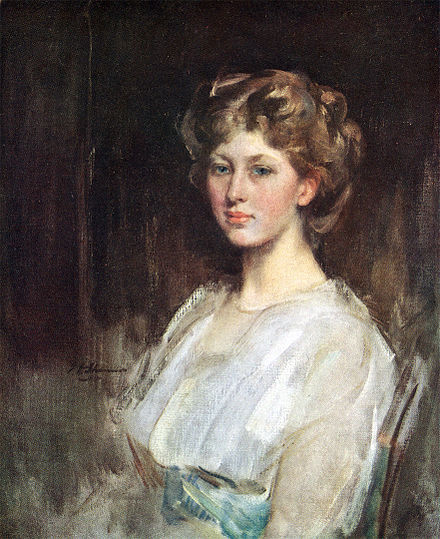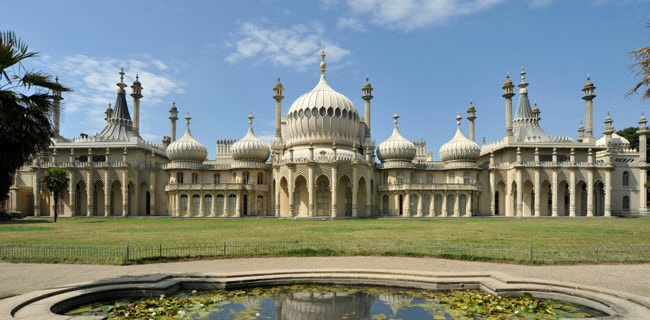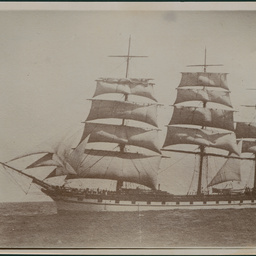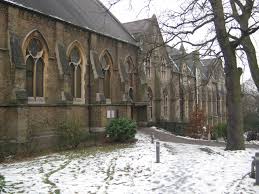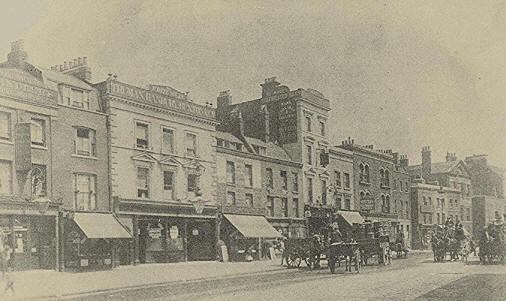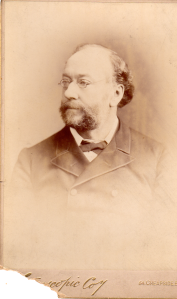Mother St George was born Frances Purssell in 1827, became a nun when she was 21. She is Lady O’B’s aunt, and Alfred Purssell’s elder sister
from The Tablet Page 24, 8th February 1908
There are not many of the nun-nurses of the Crimea left among us—not, we believe, more than four, namely, Mother Mary Aloysius, the last survivor of the band of Irish Sisters of Mercy who tended the sick and wounded in the hospitals at Scutari ; 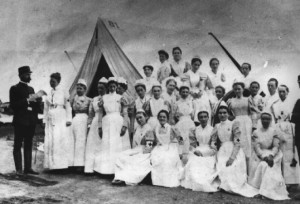 Sister Stanislas and Sister Anastasia (both now at St. John’s Wood), the representatives of the English Sisters of Mercy who gave an equal devotion to the same service ; and Mother St. George, of the Convent of the Faithful Virgin, Norwood. Of these, the first, Mother Mary Aloysius, put on record some ten years ago her wonderful experiences in that delightfully simple and graphic little book, “Memories of the Crimea.” Mother St. George resigned a few weeks ago the active headship of the branch house of her Order at Folkestone (which she helped to found) and has now returned to pass her remaining days in the Norwood Convent, where she was professed sixty years ago at the age of twenty-one.
Sister Stanislas and Sister Anastasia (both now at St. John’s Wood), the representatives of the English Sisters of Mercy who gave an equal devotion to the same service ; and Mother St. George, of the Convent of the Faithful Virgin, Norwood. Of these, the first, Mother Mary Aloysius, put on record some ten years ago her wonderful experiences in that delightfully simple and graphic little book, “Memories of the Crimea.” Mother St. George resigned a few weeks ago the active headship of the branch house of her Order at Folkestone (which she helped to found) and has now returned to pass her remaining days in the Norwood Convent, where she was professed sixty years ago at the age of twenty-one.
This week the readers of The Daily Chronicle were privileged to hear some of the reminiscences of this venerable nun, recounted in an interview which she gave to a correspondent of that paper.
“I must have five of your Sisters by seven o’clock to-morrow morning at London Bridge ready to start for Constantinople.”
Those brief, imperative marching orders from Bishop Grant were handed to the Mother Superior of the Convent of the Faithful Virgin at Norwood late in the evening of Sunday, October 22, 1854. Before six o’clock the next morning the Sisters asked for were at Bishop Grant’s house, and they started the same day with Florence Nightingale and her nurses for the East. Of that little band of five, Mother St. George was the youngest, and to-day is the sole survivor. The Order of the Faithful Virgin is a teaching, not a nursing order; but when that urgent cry of “More Nurses for the East” came from the perishing Army, there were few trained for the work who could immediately step into the breach, and hence it was that, at Bishop Grant’s summons, the Sisters of the Faithful Virgin came eagerly forward to fill the gap, and they filled it at Scutari nobly from November, 1854, till February, 1855, by which time plenty of nursing Sisters had arrived.
Mother St. George recalls the enthusiasm with which Florence Nightingale and her nurses were received when they landed at Boulogne. “Then we sailed from Marseilles” (she says); “it was a Friday, I remember, and the Captain objected to starting on Friday. The sailors were perfectly sure that the ship would go down. But Miss Nightingale would not wait ; she was anxious to reach her work as soon as possible. We had terrible weather, and the ship at one time was in very great danger in a narrow passage. However, we reached the Bosphorus safely, though I believe the ship was too damaged to make the return voyage, and Miss Nightingale said to the Captain, Why, I thought we were all to go to the bottom because we sailed on Friday ‘ ; and he answered, ‘And so we should have done if we hadn’t had Sisters on board ”
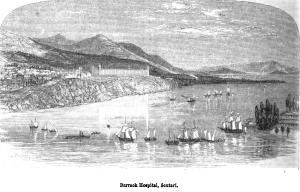 On arriving at Scutari, Mother St. George went with the other nurses to the great palace which the Sultan had placed at the disposal of the British Government for a hospital. “At that time,” she says, “all the wounded had to be brought across the Black Sea before they could be properly treated. Many died on the way across, or directly they were brought in. But the men were so good, so brave, so delicate. Why, they would try to take off their soiled bandages themselves to save the Sisters the task. And some of these men were brought in after lying out six weeks in the trenches, so that their clothes stuck to their skins, and it was difficult to remove them. There was no chloroform in those days ; so when a man had to be operated upon they used to put a ball of lead in his mouth.” Of Miss Nightingale, though she has never seen her since she left Scutari, Mother St. George retains a vivid impression. “Tall, slender, upright she was, with dark hair. Very, very gentle in her manner, but very capable. She was a wonderful nurse. And she was very accomplished, too ; she spoke three languages fluently. The officers at the hospital at Scutari did not like a woman put over them ; I think she often suffered much from that. She used to be called ‘The Bird.’ We came home in the Candia with some invalided officers and men, coming direct to Southampton. It was a Sunday morning when we reached port, and we went ashore to see if we could find a church and hear Mass. A troop of street boys followed us ; they were so astonished at our white robes, and cried that it was ‘the Emperor of Rooshia and his five daughters come over.’ ‘Them Rooshians ‘—that was how the soldiers always spoke of the enemy,” concluded Mother St. George, with a smile.
On arriving at Scutari, Mother St. George went with the other nurses to the great palace which the Sultan had placed at the disposal of the British Government for a hospital. “At that time,” she says, “all the wounded had to be brought across the Black Sea before they could be properly treated. Many died on the way across, or directly they were brought in. But the men were so good, so brave, so delicate. Why, they would try to take off their soiled bandages themselves to save the Sisters the task. And some of these men were brought in after lying out six weeks in the trenches, so that their clothes stuck to their skins, and it was difficult to remove them. There was no chloroform in those days ; so when a man had to be operated upon they used to put a ball of lead in his mouth.” Of Miss Nightingale, though she has never seen her since she left Scutari, Mother St. George retains a vivid impression. “Tall, slender, upright she was, with dark hair. Very, very gentle in her manner, but very capable. She was a wonderful nurse. And she was very accomplished, too ; she spoke three languages fluently. The officers at the hospital at Scutari did not like a woman put over them ; I think she often suffered much from that. She used to be called ‘The Bird.’ We came home in the Candia with some invalided officers and men, coming direct to Southampton. It was a Sunday morning when we reached port, and we went ashore to see if we could find a church and hear Mass. A troop of street boys followed us ; they were so astonished at our white robes, and cried that it was ‘the Emperor of Rooshia and his five daughters come over.’ ‘Them Rooshians ‘—that was how the soldiers always spoke of the enemy,” concluded Mother St. George, with a smile.
from The Tablet Page 22, 28th October 1911
 Other memories of Scutari are quickened afresh in English minds this week by the death of Mother M. Anastasia Kelly at the St. John’s Wood Convent of her Order. This event, recorded in another column, leaves but one sole survivor of the band of brave Sisters of Mercy who took ship with Florence Nightingale for the Scutari hospital wards, packed with England’s cholera-stricken soldiers. This is Mother Mary Joseph Stanislas (born Jones), of the same Convent, whose years now number eighty-nine. Elsewhere and in another Order, one other remains who shared in the horrors and glories of the Crimea. Mother St. George (born Purssell), at the Convent of the Faithful Virgin, Norwood, well recalls the day, fifty-seven years ago, when she left that house, at a few hours’ notice, in response to Bishop Grant’s appeal for volunteers.
Other memories of Scutari are quickened afresh in English minds this week by the death of Mother M. Anastasia Kelly at the St. John’s Wood Convent of her Order. This event, recorded in another column, leaves but one sole survivor of the band of brave Sisters of Mercy who took ship with Florence Nightingale for the Scutari hospital wards, packed with England’s cholera-stricken soldiers. This is Mother Mary Joseph Stanislas (born Jones), of the same Convent, whose years now number eighty-nine. Elsewhere and in another Order, one other remains who shared in the horrors and glories of the Crimea. Mother St. George (born Purssell), at the Convent of the Faithful Virgin, Norwood, well recalls the day, fifty-seven years ago, when she left that house, at a few hours’ notice, in response to Bishop Grant’s appeal for volunteers. 
Hers was not a nursing Order, but that impediment counted for naught when the supply of trained Sisters of Mercy had fallen short of the demand. The venerable Nun now dead, her surviving companion at St. John’s Wood, and Mother St. George alike received from Queen Victoria, in her Jubilee year of 1887, the decoration of the Royal Red Cross
from The Sacred Heart Review, Number 22, 16 May 1914
WHAT FLORENCE NIGHTINGALE OWED TO THE CATHOLIC CHURCH.
Mother St. George, the last survivor of the band of nuns who worked in the Crimea with Florence Nightingale, died at Norwood, England, recently, aged eighty-seven. Last week in our news columns we chronicled her funeral. The London Tablet tells of Bishop Grant’s message to the Norwood convent, in 1854, one Sunday evening: “I must have five of the Sisters by seven o’clock to-morrow morning at London Bridge, ready to start for Constantinople.” The next day the five Sisters started with Miss Nightingale. Mother St. George was decorated with the Red Cross, by Queen Victoria, many years after the war. The recently published “Life” of Florence Nightingale, written by Sir Edward Cook, quotes from a letter to the London Times,— written by its special correspondent, in the Crimea- several passages that deplore the futility of the nursing arrangements on the British side and point to the advantages of the French who had the nursing Sisters. He wrote:— Here the French are greatly our superiors. Their medical arrangements are extremely good, their surgeons more numerous, and they have also the help of the Sisters of Charity, who have accompanied the expedition in incredible numbers. These devoted women are excellent nurses. Two days after this letter appeared, a reader of the Times sent to that paper the query, “Why have we no Sisters of Charity?” Florence Nightingale was persuaded to organize a corps of nurses. ” Her experience all tells,” wrote her sister, ” including in the list of qualifications, her sympathy with the Roman Catholic system of work.” The corps included ten Catholic nuns (five from Bermondsey and five from Norwood—Mother George’s party.) Miss Nightingale was from the first anxious to have Catholic nurses on her staff, because, says her biographer:— In the first place many of the soldiers were Catholics; and, secondly, her apprenticeship in nursing had shown her the excellent qualities as nurses, of many Catholics. A letter from Miss Nightingale to Mr. Herbert described a number of her Catholic nurses as being: “The truest Christians I ever met with,—invaluable in their work, devoted, heart and head, to serve God and mankind.” When the war was at an end, the Reverend Mother, who had come from Bermondsey with the first party, returned home. What her services meant to her chief is frankly acknowledged in the letter Miss Nightingale wrote to her from Balaclava: —
“God’s blessing and my love and gratitude with you, as you well know. You know well, too, that I shall do everything I can for the Sisters whom you have left me. But it will not be like you. Your wishes will be our law. And I shall try and remain in the Crimea for their sakes as long as we are any of us there. I do not presume to express praise or gratitude to you, Reverend Mother, because it would look as if I thought you had done the work not unto God but unto me. You were far above me in fitness for the general superintendency, both in worldly talent of administration and far more in the spiritual qualification which God values in a Superior. My being placed over you in an unenviable reign in the East was my misfortune and not my fault.”
From her childhood Florence Nightingale showed a vocation for nursing. She nursed and bandaged the dolls her sister broke, and she gave “first aid to the wounded” to a collie with a broken leg. The earliest sample of her writing is a tiny book, which the child stitched together and in which she entered in very uncertain letters a recipe ” sixteen grains for an old woman, eleven for a young woman, and seven for a child.” The conventions of her day and class forbade the following of her desire to become a nurse. The advantages of wealth and culture were hers, including travel and study in foreign countries. The chief attraction that Paris offered to her ” lay principally in its hospitals and nursing Sisterhoods.” Her beautiful home at Embley appealed to her chiefly as a desirable place for a hospital— ” I think how I should turn it into a hospital and how I should place the beds,” she said to a friend. When Dr. Howe visited Embley, Florence asked him; “If I should determine to study nursing, and to devote my life to that profession, do you think it would be a dreadful thing ? ” ” Not a dreadful thing at all,” replied the visitor. “I think it would be a very good thing.” To Catholic Sisterhoods she owed the opportunity that opened the way to her future career. She wrote on one occasion:— “The Catholic Orders offered me work, training for that work, sympathy and help in it, such as I had in vain sought in the Church of England. The Church of England has for men bishoprics, archbishoprics, and a little work. For women she has what ? I would have given her my head, my heart, my hand. She would not have them. She did not know what to do with them. She told me to go back and do crochet in my mother’s drawing-room; or, if I were tired of that, to marry and look well at the head of my husband’s table. You may go to the Sunday-school, if you like it, she said. But she gave me no training even for that. She gave me neither work to do for her, nor education for it.” In Rome, the great attraction for Miss Nightingale was the Sacred Heart Convent, but for nursing Sisterhoods she retained always the deepest regard. Her latest biographer says: — She thought more often, and with more affectionate remembrance, about the spirit of the best Catholic Sisterhoods than of Kaiserswerth, or indeed of anything else in her professional experience. At Kaiserswerth, an ancient town on the Rhine, there was a hospital conducted by Deaconesses, (Protestant) and here Miss Nightingale spent some months. That Kaiserswerth trained her, she herself denied. “The nursing there was nil,” she wrote. “The hygiene was horrible. The hospital was certainly the worst part of Kaiserswerth. I took all the training there was to be had; Kaiserswerth was far from having trained me.” From the Protestant Deaconesses of Germany, Miss Nightingale went to live among Catholic Sisters in France. Dr. Manning secured the opportunity for her to study in their institutions and hospitals. ” Florence joined the Sisters of Charity in Paris. “And thus after many struggles and delays, was she launched upon her true work in the world,” states Sir Edward Cook. In 1854 came the “call” to the Crimea and the practical test of Miss Nightingale’s vocation for nursing. Of her companions to the Crimea we have already learned something, and more is related in a general way in the chapters dealing with her experiences as an army nurse. A small black pocket-book, found among Miss Nightingale’s effects, after her death, contained a few of the letters she received before starting for the East. One of these letters, was from Dr. Manning, who wrote:— “God will keep you. And my prayer for you will be that your one object of Worship, Pattern for Imitation, and source of consolation and strength may be the Sacred Heart of our Divine Lord.” Summing up Miss Nightingale’s feeling towards Catholics and Catholicism, Sir Edward Cook says: — “There were many points at which Roman Catholicism appealed to her. Cardinal Manning, for whom she entertained a high respect, may sometimes have regarded her as a likely convert; but towards acceptance of Roman doctrines, I find no ground for thinking that she was at any time inclined. Yet the spirit of Catholic saintliness—and especially that of the saints whose contemplative piety was joined to active benevolence— appealed strongly to her. She read books of Catholic devotion constantly, and made innumerable annotations in and from them. . . She admired intensely the aid which Catholic piety had given, and was giving to many of her own friends—to the Bermondsey nuns, especially, and to the mother and sisters of the Trinitade’ Monti — towards purity of heart and the doing of everything from a-right motive. Then, again, to be ” business-like” was with Miss Nightingale almost the highest commendation; and in this character also the Roman Church appealed to her. Its acceptance of doctrines in all their logical conclusions, seemed to her business-like; its organization was businesslike; its recognition of women-workers was business-like.”
